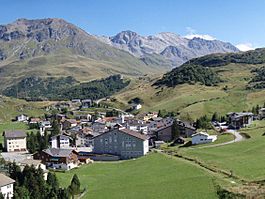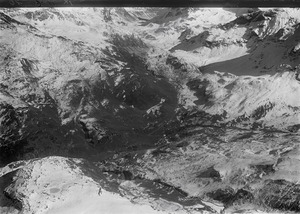Bivio facts for kids
Quick facts for kids
Bivio
|
||
|---|---|---|
 |
||
|
||
| Country | Switzerland | |
| Canton | Graubünden | |
| District | Albula | |
| Area | ||
| • Total | 76.73 km2 (29.63 sq mi) | |
| Elevation | 1,769 m (5,804 ft) | |
| Population
(Dec 2014)
|
||
| • Total | 189 | |
| • Density | 2.463/km2 (6.380/sq mi) | |
| Postal code |
7457
|
|
| Surrounded by | Avers, Bever, Marmorera, Mulegns, Sils im Engadin/Segl, Silvaplana, Soglio, Stampa, Sur | |
Bivio (Romansh: Beiva, German: Stallen) is a small village in the Swiss canton of Graubünden. It used to be its own municipality in the Sursés region. On January 1, 2016, Bivio joined with several other villages. They all merged to form the new municipality of Surses.
Contents
History of Bivio
Bivio is a very old village. It was first mentioned in records around the year 840. Back then, it was known as de stabulo Bivio. For a long time, its German name was Stallen. Until the early 1900s, it was also known by its Italian name, Stalla.
Geography of Bivio
Bivio covers an area of about 76.7 square kilometers (about 29.6 square miles). A large part of this land, almost half, is used for farming. A small portion is covered by forests. Only a tiny bit has buildings or roads. The rest of the land is made up of non-productive areas. These include rivers, glaciers, or mountains.
The village is located on important roads. These roads lead to the Julier and Septimer pass. Bivio is unique because it's the only village north of the main European watershed that traditionally spoke Italian. However, today, most people in Bivio speak German. There are also many people who speak Romansh and Italian. The village of Bivio includes smaller areas. These are called Stalveder, Mott, Cavreccia, and Valetta da Beiva.
People and Population in Bivio
Bivio had a population of 189 people in 2014. About 14.3% of the people living there in 2008 were foreign nationals. This means they were from other countries. Over the past 10 years, the population has slightly decreased.
In 2000, the population was almost evenly split between males and females. About 47.5% were male and 52.5% were female. The village has people of all ages. For example, about 10.3% of the population was under 9 years old in 2000.
Most people in Switzerland are well-educated. In Bivio, about 58.5% of adults (aged 25-64) have completed higher education. This could be a university degree or a specialized college degree.
Bivio has a low unemployment rate, which means most people have jobs. In 2005, many people worked in the service industry. This includes jobs like tourism and shops. Some people also worked in farming and manufacturing.
The population of Bivio has changed over time. You can see how the number of people has gone up and down in the chart below.

Climate in Bivio
Bivio experiences a good amount of rain each year. On average, it rains about 132 days a year. The village receives about 1198 millimeters (47 inches) of rain annually. August is usually the wettest month. During August, Bivio gets about 138 millimeters (5.4 inches) of rain. It rains for about 11.9 days in August. May has the most rainy days, about 13.1 days. However, the total rainfall in May is less than in August. February is the driest month. It receives about 56 millimeters (2.2 inches) of rain.
Languages Spoken in Bivio
For many centuries, three languages have been spoken in Bivio. Italian was the official language for a long time. However, German has become more common over the years. The local Italian dialect is called Bargajot. The local Romansh dialect is a mix of two main types: Surmiran and Puter. Even the German spoken here has its own local dialects.
In 1880, most people spoke a Romance language. This included Italian or Romansh. By 2000, most people (55.4%) spoke German. Italian was the second most common language (29.4%). Romansh was third (12.3%). The table below shows how the languages spoken in Bivio have changed over the years.
| Language | 1980 Census | 1990 Census | 2000 Census | |||
|---|---|---|---|---|---|---|
| Number | Percentage | Number | Percentage | Number | Percentage | |
| German | 88 | 36.97% | 120 | 53.81% | 113 | 55.39% |
| Romansh | 44 | 18.49% | 20 | 8.97% | 25 | 12.25% |
| Italian | 100 | 42.02% | 76 | 34.08% | 60 | 29.41% |
| Population | 238 | 100% | 223 | 100% | 204 | 100% |
Important Historical Sites
An important discovery was made in the Julier Pass area. This was an ancient Roman mountain shrine. This site is considered a very important Swiss heritage site. It is protected as a cultural property of national significance.
See also
 In Spanish: Bivio para niños
In Spanish: Bivio para niños






